There are many ways of expressing resistance to the occupation through art. For me art has become the only peaceful weapon available to express and transmit all of the ways in which I suffer to the world. Resistance through art, or as I like to call it “white resistance,” is where art arises as a form of struggle itself.
Artists in Palestine do not want to paint an image of resistance in their art, but aim as much as possible to make art a weapon through which they resist everything that is unjust, whether it is against the occupation, war, wrongheaded social norms and traditions, killings, violence or anything that is corrupt or contradicts humanitarian values.
My love for drawing only started when I was under house arrest. I started to draw my feelings while locked inside my room to release all the negative energy that was built up in my heart as a result of detention, especially because I was deprived of practicing my love of photographing outdoors in places I loved to visit. Therefore, drawing came to give me a positive push to keep me going, resisting and struggling, and to replace my passion for photography and no longer free use of my camera during this long period of time.
After I was sentenced to five months of jail and during my time at Damon prison, my need to write, and more than ever before, became a way to express my resistance against jail and the injustice I faced every day due to the imprisonment of my freedom. However, suddenly and with writing, I felt capable of drawing too and expressing all I saw and lived in this jail through simple drawings that transfer reality as it is, and the feelings I or other women prisoners lived.
The Israeli Prison Services ban us, Palestinian women prisoners that is, from using colors, paints, books and all drawing equipment, yet they allow them in criminal prisons. This ban and restriction was not an obstacle for us. Whoever wanted to draw and express her feelings in jail would do so with the minimum of available means.
The drawing equipment I used in jail was very simple. I illustrated with pens in three colors, blue, black and red, and a pencil that is the only available one in the section where I was assigned. It was secretly smuggled, used by all prisoners who wanted to use a pencil. In order to use it one would wait in turn and pre-reserve.
My eraser in jail was merely a small piece of black leather on the handle of a hair brush and my sharpener for the pencil was the cement ground of the prison’s yard; I would scratch the pencil to the ground until it became good for drawing. As for the drawing paper I used in jail, they were the paper of a regular lined book that I use for writing. Sometimes I would collect the cardboard covers of disposable aluminum plates, used for special meals given to prisoners with diabetes or blood pressure diseases. These would only be available for me to draw on if the covers remained clean and unstained by food. I then gave these drawings to my prisoner friends to keep.
Today, after being released and having all drawing equipment available, I still feel that the drawings I drew in jail had more meaning and are different than any other drawing I do while free at home. My drawings from jail are very simple. To the observer’s eye they may seem to lack mastering and the real technique of drawing, however, they came from a suffering heart, deprivation and a lack of equipment and means. Thus they have a big place in my heart. Each drawing I drew in jail, even if it was simple and merely some momentary scribbles, has a meaning that I lived in jail and a visualized message about something happening that only women prisoners themselves know. These are some of my drawings from jail, each has a story.

Picture no. 1: As soon as I arrived into jail, all of my belongings were confiscated. I was even banned from bringing in my own clothes. The jailer cuffed my hands and shackled my legs. When I objected and asked her why, she said because I am a security prisoner and I am a threat to the security of the state and jailers. After arriving into section 61 of the Damon prison I saw two cells: cell number 7 and cell number 8, everything fenced, locked and surrounded with walls, even windows were sealed with iron and fenced from every side.
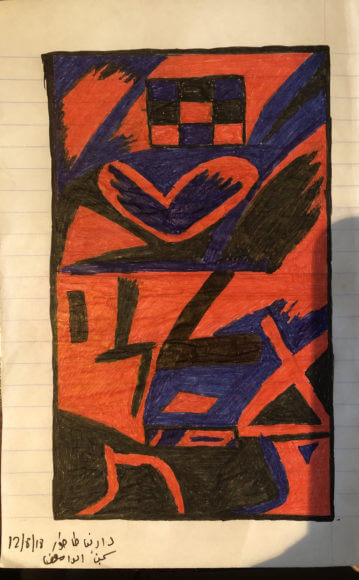
Picture no. 2: During the times where I would sit in my cell empty of all that is lively, hopeful and colorful, I would look at its corners and see gray walls and beds, and in front of me. Wherever my eyes would look, and because of how small this cell is, I would see the closed gray door. Suddenly, I felt a desperate need for my eyes to see colors, to see a different color than the dominant gray in this cell. I wished that I had paint to color that door with other colors full of life and optimism or colors that tell the reality of feelings that moved inside me and the seven prisoners with me. Nevertheless, my wishes would not get me anything. I opened my book and drew the door of the cell as it is. Then I started to color it in with the colors I had available in accordance with my feelings and sensations.
Red, was for the feelings of love and longing that I had for my friend at that moment; black was for the darkness of the cell and the noise I lived all the time with the prisoners and the lack of privacy; and blue symbolized the occupation that always disturbs the clarity of our lives for us Palestinians. The state of longing produced inhibitions, contradictions, pain, hope and agony that I found here, and released through the colors engraved in the drawings.

Picture no. 3: There’s a story about the sea in jail. I had missed the sea a lot when I drew this drawing but there is something deeper that controlled my feelings and was tougher on me than longing itself. When I thought of the sea, here, I saw women prisoners and their longing to see this sea! Talking about the sea anywhere in the world is something normal but talking about it in jail and in Palestine, and specifically with Palestinian women prisoners, had a certain pain. All the women prisoners I was with had not seen the sea in their lifetimes but through pictures due to checkpoints, the separation wall and the occupation that prevents Palestinians in the West Bank from visiting the coastal area. Many were deprived of permits that could have helped them cross these checkpoints.
Generations have grown up and are still growing up in Palestine and have never gone to the sea and do not know the real meaning of the sea, its contours, or the feeling one has when swimming.
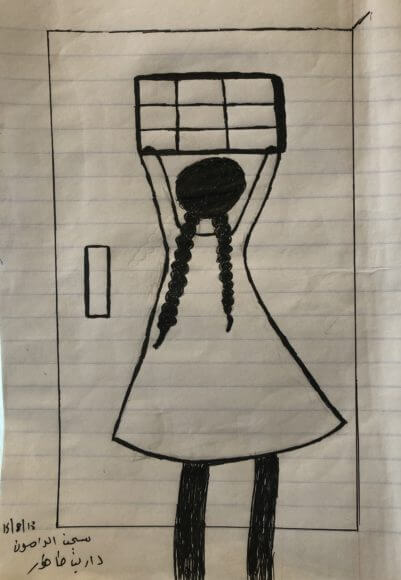
I did not have the color green with me in jail which kept me from finishing the Palestinian flag on the boat’s sail in the drawing. I felt banning color pencils was similar to the confiscation of Palestinian rights to see the sea. Despite the fact that both of these requests are humanitarian and very simple—indeed the simplest of human rights—yet banning them causes deep pain and leaves an indelible effect in the heart.
Picture no. 4: Some of the darkest feelings that overtook my heart while in jail came from the longing for a friend. I felt loneliness, suffering, love, and pain. I called out for those my heart missed without anyone hearing so much as an echo. That is when I wanted to shout and yell her name, but it was of no use. My voice could not reach her from behind the iron door. So I imagined a conversation transmitted by our hearts. But in reality any sound I made was buried inside of my cell. Love was buried; the heart was bound and the call was only received by the walls of this prison.
Pictures no. 5 and 6: These images are of the beds in the cell. Constructed of iron and topped by a very thin mattress, sleeping on them was like sleeping on a sheet of tinplate. The uncomfortable mattress caused me back pain. There was nothing in the cell but these beds and gray lockers. This was the only furniture available for women prisoners.
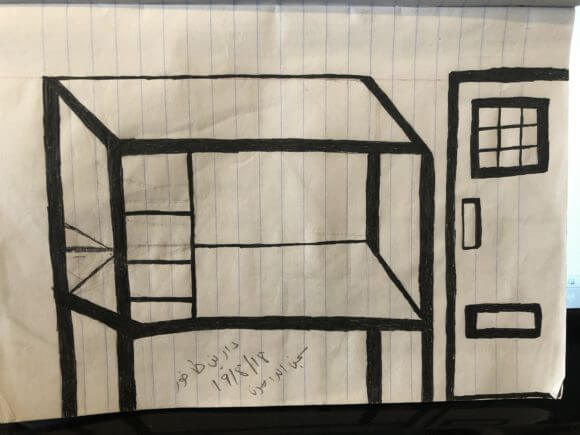
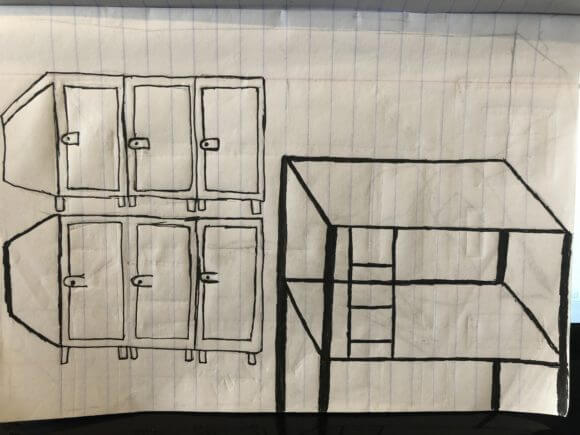
Picture no.7: That iron door is the harshest scene I have seen in my life, escorting me at all time and through the opening where I could always see the sky in a square. A huge iron door, I often had the feeling to and wished that I could break that door, or open it and leave whenever I wanted. What a hard feeling it is to be tied to place where the times to open and shut the door on you are controlled. At this specific moment when I made this drawing, I felt an urgent need to get out and breathe. I even wanted to shower whenever I felt the need to wash my body of the tiredness of thinking, with cold water, but also could not do that as shower rooms are also tied to certain times that I do not control. I went with imagination towards freedom. I wanted to put a hole in that door. I started drawing circles on it, yet, these holes suddenly appeared as extra restrictions. That door is a symbol for the ruggedness of the jailer and my inability as a prisoner. The only way for me to open that door was writing about it or draw it as open like it was in my imagination.

Picture no.8: In the cell, lights are turned off at 11:00 p.m., and at this exact time rooms become quiet and silence begins after a day full of indescribable noise. That is the only time I would have a state of quietness that would help me write and read in jail, but my problem was that there was no light to help me read and write. The only available light came from a small opening in the door that beamed into my cell. I would sit on the ground by the door to use this, the only light entering the cell. Under this light I wrote my poems and drew some of these drawings.


Picture no.9: Being imprisoned only because of writing where my only crime was having used a pencil to write a poem, I came to see freedom of expression and democracy in Israel as a big lie; there is no such thing as the freedom of expression for us Palestinians. The pencil represents me, the pencil here is my imprisoned body. It is also the pencil that we as prisoners are banned from using; this ban itself is a symbol of the racism we face. Pens of all types are available in Israeli criminal prisoners but are banned for political prisons where only Palestinians are held. A state that imprison a poet because she wrote a poem and bans pencils in that prison, it is a racist not a democratic state.
To me, more writing and more drawing means more resistance and more struggle against the occupation and its acts against us Palestinians. More art means more holding onto the land, history and identity. It means more expression where injustice is rejected, and publicly saying “no” to occupation.
Those who have a talent live with a cause, and artists who have a cause in their art do not let it go no matter how expensive the price is and no matter how much forces beyond their control try to silence them. With censorship, artists back their causes even stronger and in additional means. Thus, in inaccessible places and where nobody can know what is happening in terms of human rights violations, comes the talent who will express what is hidden, comes art in jail to specifically send an image to the outside world and tell on and document these violations.

Resisting anything that is unjust needs a tool. My tool in jail was my pencil, my poetry and my feelings. With these I wrote and I drew.
After I being imprisoned for three years for writing a poem against the occupation, I do not rule out that I could find myself in detention once again. This time perhaps for a drawing or a picture depicting the occupation, expressing resistance or my Palestinian identity and my home country. A drawing in which I criticize all of the occupation’s violations and its racism against us Palestinians–because everything here that has a Palestinian identity has become incitement and terrorism for the Israeli government–could be called a crime. A look could be called a crime. Using certain colored pencils could be called a crime.
After I was tried and convicted for a word and a thought, I wonder will I ever be locked up for a drawing too? I leave the answer here in two of the above drawings that I did while under house arrest. Maybe these will have an explanation of the reality I lived, am still living and will live in a state that only knows killing Palestinians, and fights everything that expresses them.
This article was translated from Arabic to English by Nina AbuFarha.


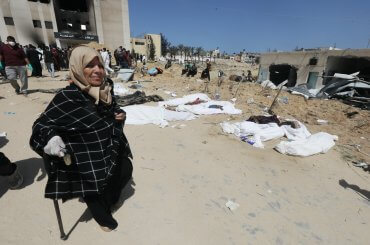
the pencil was smuggled into her cell
“Being imprisoned only because of writing where my only crime was having used a pencil to write a poem, I came to see freedom of expression and democracy in Israel as a big lie; there is no such thing as the freedom of expression for us Palestinians. The pencil represents me, the pencil here is my imprisoned body. It is also the pencil that we as prisoners are banned from using; this ban itself is a symbol of the racism we face. Pens of all types are available in Israeli criminal prisoners but are banned for political prisons where only Palestinians are held. ”
just wow
Ah, yes, “Israel a light unto nations [not]”
https://electronicintifada.net/blogs/tamara-nassar/israeli-settlers-vandalize-west-bank-mosque
“Israeli settlers vandalize West Bank mosque”
By Tamara Nassar Electronic Intifada, Rights and Accountability5 February 2019
“Israeli settlers vandalized a mosque with Hebrew-language graffiti on Monday in the occupied West Bank village of Deir Dibwan near Ramallah.
“Settlers also poured flammable material on the shoe rack placed at the entrance of the mosque.
“Among the anti-Palestinian slogans were, ‘Here they incite to murder Jews’ and ‘The Jewish nation lives,’ as well as the Star of David symbol.
“This kind of vandalism is often called a ‘price tag’ – a term Israeli settlers and extremists use to describe sometimes lethal attacks on non-Jews and their property, especially Palestinians.
“Yousef Idis, the Palestinian Authority’s religious affairs minister, condemned the settler attack.
“’There are no longer safe places of worship in light of Israeli forces and settlers’ attacks and crimes [against the Palestinian people],’ Idis said, according to Palestinian news agency WAFA.
“Israeli police have opened an investigation into the suspected hate crime, according to Israeli daily Haaretz.
“But data from the Israeli human rights group Yesh Din show that just three percent of Israeli police investigations of ‘ideologically motivated’ crimes against Palestinians by Israeli civilians result in a conviction.
“Increasingly, according to Yesh Din’s research, Palestinians do not even bother to report crimes against them to the Israeli police, given the effective impunity Israeli perpetrators enjoy.
Incursions:
“On Tuesday, Israeli agricultural minister Uri Ariel made an incursion into the al-Aqsa mosque compound in occupied East Jerusalem, accompanied by settlers.
“Ariel is a prominent advocate for the destruction of the existing Muslim holy sites, including the al-Aqsa mosque and the Dome of the Rock, and their replacement with a Jewish temple.
“Settlers regularly storm the al-Aqsa compound escorted by heavily armed occupation soldiers to intimidate Palestinians and assert Israeli control over the site.
“Previously, Israeli lawmakers were not allowed to visit al-Aqsa mosque due to an agreement between Jordan – the custodian of holy sites in Jerusalem – and Israel. Al-Aqsa mosque is one of Islam’s holiest sites.
“Israeli Prime Minister Benjamin Netanyahu announced in July that lawmakers may visit the al-Aqsa mosque compound, which Jews call the Temple Mount and Muslims call al-Haram al-Sharif, once every three months.
“Following Israel’s military occupation of East Jerusalem in 1967, Israel’s chief rabbis banned Jewish prayer on the Temple Mount for theological reasons.
“But these religious rulings are defied by right-wing extremists bent on conquering the site once and for all.
“Increasingly aggressive incursions align with plans to erase Jerusalem’s Muslim and Christian identity and reinvent Jerusalem’s history according to a Zionist narrative, pushing Palestinians out of the city.
“The ultimate aim of the so-called Temple movement, which is funded by the Israeli government, is to build a Jewish temple where the Muslim shrines now stand.
“Israeli settlers also surrounded the al-Disi mosque in the Old City of Jerusalem on Sunday and demanded its closure:
“The mosque was recently renovated and is set to reopen for use after years of standing vacant.
“Israeli settlers in the area are generally against the mosque’s opening due to its proximity to the Jewish Quarter, calling it a ‘provocation,’ Israel’s Ynet reported.
“A local rabbi sent a letter to the Israeli police demanding intervention.
“In response, the Israeli municipality ruling occupied East Jerusalem stated that it demolished a room that had been built on the mosque’s roof.
Vandalized cars
“Elsewhere, settlers have stepped up hostilities against Palestinians in recent weeks, including vandalizing cars, storming holy sites, damaging olive trees and attacking Palestinian residents.
“In the occupied West Bank village of al-Mughayyir late last month, 38-year-old father of four Hamdi Talib Saadeh Naasan was fatally shot as settlers and soldiers firing guns stormed the village.
“Last week, Settlers vandalized cars belonging to Palestinians in the West Bank village of Luban al-Sharqiya south of Nablus.
“Israeli settlers smashed the windows of three cars in the village of Turmus Aya near Ramallah late last month.
“Video of the attack shows three masked people striking the cars with what looks like steel batons and then fleeing the area.”